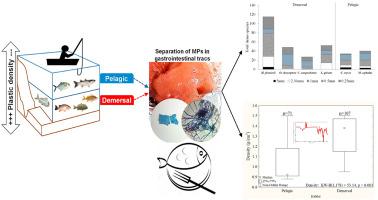Environmental Pollution ( IF 7.6 ) Pub Date : 2020-09-18 , DOI: 10.1016/j.envpol.2020.115659 Merle M. Borges-Ramírez , Edgar F. Mendoza-Franco , Griselda Escalona-Segura , Jaime Rendón-von Osten

|
Microplastics (MPs) are currently one of the primary marine pollution problems around the world. MPs are distributed throughout the water column, dependent mainly on the density that is given by the polymer type, as well as the location, depth, and velocities of the water flows. This situation allows all aquatic organisms to be exposed to MPs. Furthermore, toxic substances can adhere to the MPs, making the consumption of fish with MPs a risk to human health. The aim of this study was to evaluate and characterize the microplastics present in the gastrointestinal tract of six species of fish which had the highest human consumption in Campeche, Mexico and their relationship with the density of MPs founded. A total of 316 microplastic particles from 240 individuals were found with 1.31 ± 2.59 of microplastics per fish. The results indicate that there are differences (KW-H = 53.14) between the densities of the MPs present in demersal fish (1.41 ± 0.4 g·cm-3) with respect to the pelagic species (1.04 ± 0.24 g·cm-3). Likewise, differences were found between fibers, fragments, and pellets present in the studied fish with a pelagic: demersal ratio of 1: 2.4 for all microplastics. The demersal species Haemulon plumierii (n = 40) presented the highest number of MPs with 115 items in total, 73 fibers, and 42 fragments. The results of this research show the first evidence that the density of the material from which microplastics are made play a key role determining their fate in marine fish habitats.
中文翻译:

可塑性密度是墨西哥坎佩切湾市商业鱼类胃肠道中存在微量塑性的关键因素
目前,微塑料(MPs)是全球主要的海洋污染问题之一。MPs分布在整个水柱中,这主要取决于聚合物类型给定的密度以及水流的位置,深度和速度。这种情况使所有水生生物都暴露于MPs中。此外,有毒物质会附着在MP上,使食用MP的鱼类对人类健康构成威胁。这项研究的目的是评估和表征在墨西哥坎佩切州人类食用量最高的六种鱼类的胃肠道中存在的微塑性及其与所建立的MP密度的关系。共发现来自240个个体的316个微塑料颗粒,每条鱼的微塑料含量为1.31±2.59。-3)相对于浮游类(1.04±0.24 g·cm -3)。同样,对于所有微塑料,在研究鱼类中存在的纤维,碎片和颗粒之间存在差异,浮游比:沉没比为1:2.4。在海藻中,Haemulon plumierii(n = 40)的MP数量最多,共有115种,73种纤维和42个碎片。这项研究的结果表明,第一个证据表明,制造微塑料的材料的密度在决定其在海鱼栖息地中的命运方面起着关键作用。









































 京公网安备 11010802027423号
京公网安备 11010802027423号